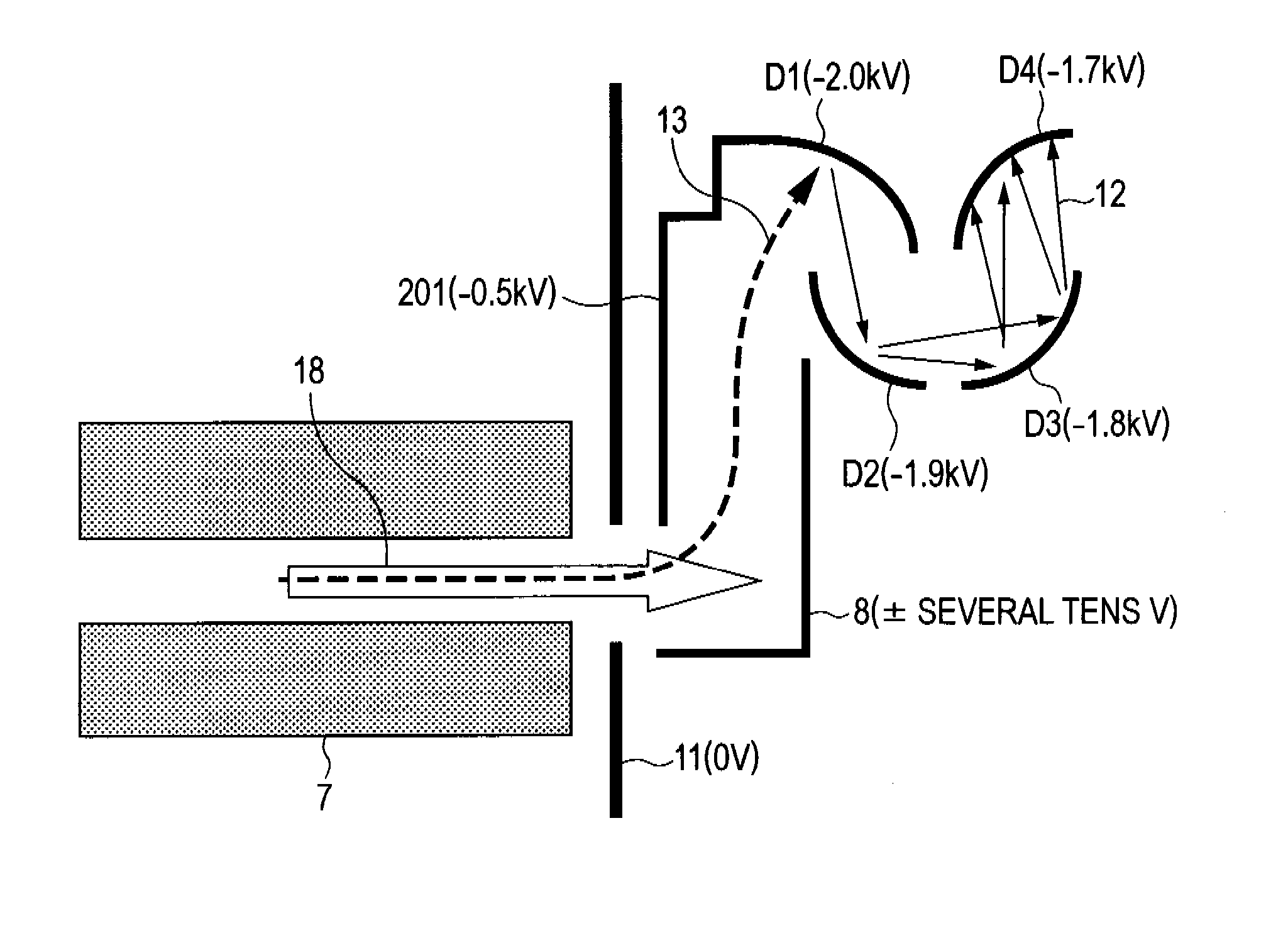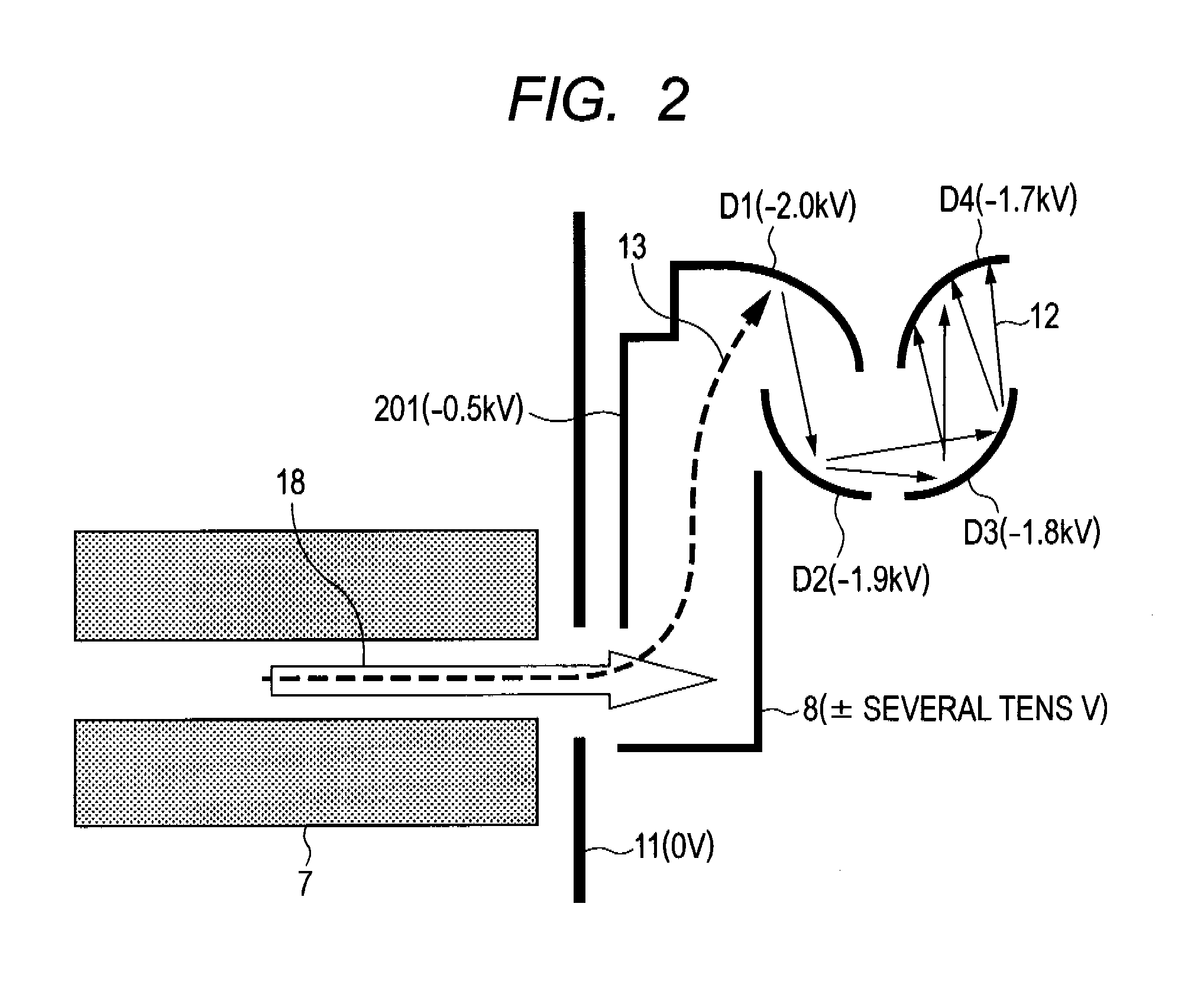Ion detector for mass spectrometry, method for detecting ion, and method for manufacturing ion detector
a technology of mass spectrometry and ion detector, which is applied in the direction of instruments, particle separator tube details, separation processes, etc., can solve the problem that s/n has not become of sufficient performance, and achieve the effect of improving the effect of stray light reduction
- Summary
- Abstract
- Description
- Claims
- Application Information
AI Technical Summary
Benefits of technology
Problems solved by technology
Method used
Image
Examples
first embodiment
[0117]FIG. 1A is a schematic view showing a part of the mass spectrometer according to the embodiment of the invention, and is a schematic view for explaining an ion analysis unit. FIG. 1B is a perspective view of the lead-in electrode of the ion analysis unit in FIG. 1A.
[0118]In the embodiment, the secondary electron multiplier has 20 stage electrodes, but, in FIG. 1A, electrodes up to the fourth stage (four electrodes) are shown. In the embodiment, the electrode D1 provided at the first-stage of the secondary electron multiplier and the electrode D2 provided at the second stage are provided facing each other, and a kth electrode Dk (k is an integer of 2 or more) is provided, facing a (k−1)th electrode Dk−1 being the electrode of the previous stage thereof and a (k+1)th electrode Dk+1 being the electrode of the rear stage thereof.
[0119]That is, each of electrodes D1 to D20 is provided so that an electron generated by the collision of an ion against the electrode D1 provided for the...
second embodiment
[0130]FIG. 2 is a schematic view showing a part of the mass spectrometer according to the embodiment, and a schematic view for explaining an ion analysis unit. The embodiment is different from the examination example of the invention only in that the applied potential to a lead-in electrode 201 is −500 V, and the others are the same.
[0131]In the embodiment, the ion 13 ejected from the mass aperture board 11 is pulled in toward the SEM 9 direction mainly by the electric field by the lead-in electrode 201, wherein the applied potential to the lead-in electrode for pulling in the ion is changed from −2 kV in the examination example of the invention to −500 V. Accordingly, the ion pull-in effect is reduced a little, but, when compared with the second and third conventional examples, the detection efficiency for original ions to be detected is considerably improved. And, although the amount of high-energy electrons generated on the lead-in electrode 201 is the same as that in the examina...
third embodiment
[0138]FIG. 3A is a drawing showing a part of the mass spectrometer according to the embodiment, and is a schematic view for explaining an ion analyzer. FIG. 3B is a perspective view showing the lead-in electrode and the deflection board of the ion analyzer shown in FIG. 3A. The embodiment is different from the examination example of the invention only in that the deflection board 8 is divided into two and, to a second deflection board 302 facing the lead-in electrode 20 of the deflection boards divided into two, a potential of −1.5 kV is applied, and the others are identical.
[0139]As shown in FIGS. 3A and 3B, the embodiment uses two deflection boards 301 and 302. And, to the deflection board 301 provided on the previous stage side in the traveling direction of the ion 13, a potential of ±several tens V is applied, and, to the deflection board 302 provided on the rear stage side, a potential of −1.5 kV is applied.
[0140]Most of high-energy electrons generating on the lead-in electrode...
PUM
 Login to View More
Login to View More Abstract
Description
Claims
Application Information
 Login to View More
Login to View More - R&D
- Intellectual Property
- Life Sciences
- Materials
- Tech Scout
- Unparalleled Data Quality
- Higher Quality Content
- 60% Fewer Hallucinations
Browse by: Latest US Patents, China's latest patents, Technical Efficacy Thesaurus, Application Domain, Technology Topic, Popular Technical Reports.
© 2025 PatSnap. All rights reserved.Legal|Privacy policy|Modern Slavery Act Transparency Statement|Sitemap|About US| Contact US: help@patsnap.com



